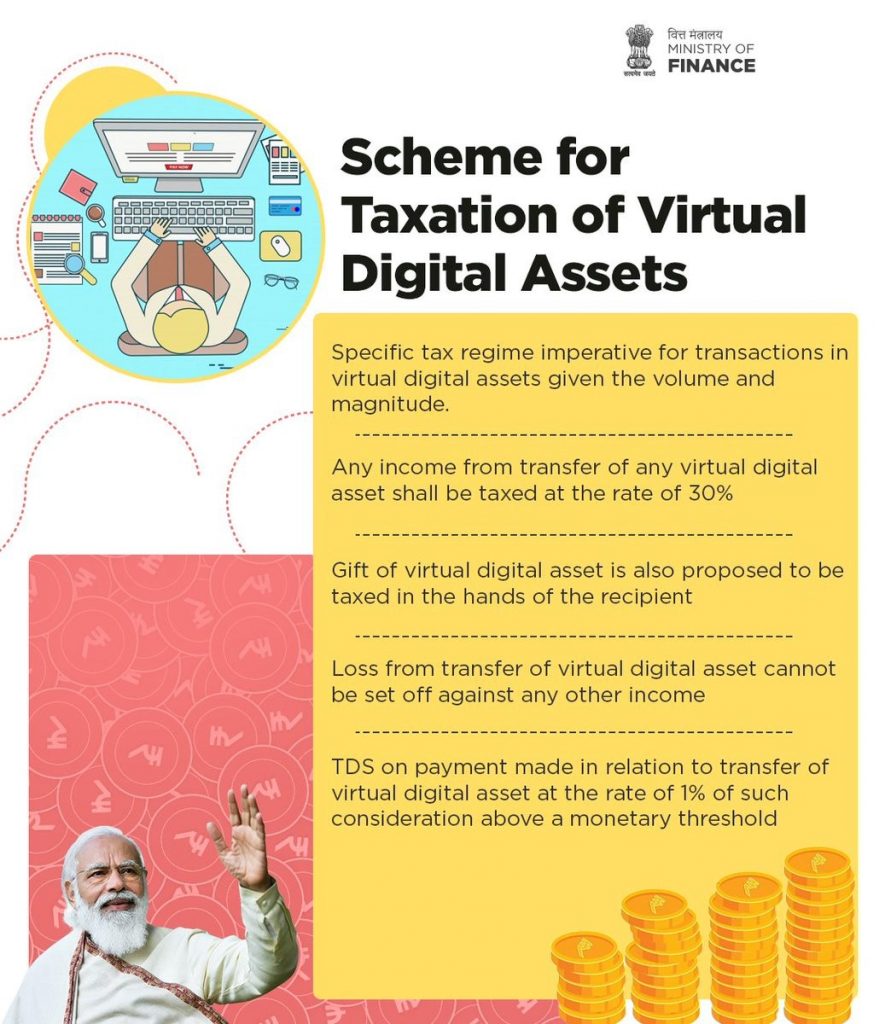[ad_1]

Context:
One of the most striking moves in the Union Budget’s taxation proposals for 2022-23 is the introduction of a taxation regime for virtual digital assets — evolving manifestations of cryptocurrencies, codes and non-fungible tokens.
The government has proposed to issue a Digital Rupee, or Central Bank Digital Currency (CBDC), in the fiscal year 2022-23.
Additionally, the Budget also proposed imposing a tax of 30 per cent on virtual assets, effectively legitimising trading of private cryptocurrencies and non-fungible tokens.
This is broadly in line with the Centre’s plans to have a fiat digital currency, while disallowing use of private virtual coins as legal tender.
Virtual digital assets such as cryptos, NFTs to be taxed at 30%:
Finance Minister has proposed to tax all profits from transactions in such assets at 30% along with the applicable surcharge and cess, and a 1% tax to be deducted by buyers while trading in any virtual digital asset beyond a threshold.
- While the tax on profits will apply from April 1, 2022, which officials said will not preclude profits already booked before that date from the tax liability, the TDS provisions aimed at creating a transaction trail for the tax authorities, will kick in from July 1.
- While trading profits will be taxed at, according to crypto industry players, a higher rate compared to other jurisdictions, no deductions will be allowed on account of setting off losses from such trading or from any other capital losses.
- The only deduction permitted would be the cost of acquiring the asset. The term ‘property’ under the I-T Act is being expanded to include virtual digital assets so that such assets received as a gift shall be taxable except when received from relatives.
About Virtual Digital Assets:
- As per the proposed new clause, a virtual digital asset is proposed to mean any information or code or number or token (not being Indian currency or any foreign currency), generated through cryptographic means.
- Virtual digital assets have gained tremendous popularity in recent times and the volumes of trading in such digital assets has increased substantially.
- Virtual Digital Assets also include Non-fungible tokens or NFTs , which are cryptographic assets on a blockchain with unique identification codes and metadata that distinguish them from each other.
- NFTs can also be used to represent individuals’ identities, property rights, and more.
- This differs from fungible tokens like cryptocurrencies, which are identical to each other and, therefore, can be used as a medium for commercial transactions.
- Further, a market is emerging where payment for the transfer of a virtual digital asset can be made through another such asset. These factors have made it imperative to provide for a specific tax regime.
What is the significance of RBI’s Digital Rupee?
With the introduction of Central Bank Digital Currency (CBDC), India’s digital economy will witness a significant boost. Central Bank Digital Currency (CBDC) will give a big boost to the digital economy.
Digital currency will also lead to a more efficient and cheaper currency management system.
Earlier in October 2021, the Reserve Bank of India (RBI) received the nod for an amendment to the Reserve Bank of India Act, 1934 to enhance the scope of the definition of ‘bank note’ to include currency in digital form.
Determining the legal position of virtual currency:
- The taxation regime by itself, Finance Minister has emphasised, does not grant legitimacy to the trade in these currently unregulated assets. A consultation process is underway, which will determine the legal position of such assets.
- This provides some relief for the growing flock of crypto investors. The Government may still not consider them fully legit, yet the tax regime indicates the hard option of an outright ban that was signalled in the nomenclature of a proposed crypto law last year is off the table.
- Listed first for Parliament’s monsoon session, then again in the winter, that legislation is also now off the agenda.
- The delay in arriving at a decision also pre-empts Indian start-ups and innovators from developing products and ideas that can be scaled up globally given the nature of these assets.
- Some countries are also adopting a phased approach in regulation wherein they are focusing on regulating cryptoassets that are presently the dominant use case in such jurisdictions.
- Specifically, jurisdictions such as Hong Kong, the United States of America and the United Kingdom are focussing on developing regulations for stablecoins, which is the prevalent use case presently in such countries
Along with the Proposed Law, India must also focus on investment in creating a specialized task force consisting of skilled officers for enforcing the provisions of the law, investment in investor education and also fostering partnerships with other countries for effectively regulating crypto assets.
Conclusion:
Virtual currencies are digital representations of value that can exist only in electronic form.
Their transactions occur on online networks or the Internet. Examples of virtual currencies include tokens and cryptocurrencies. Virtual currencies are a novel form of currency and, as such, are mostly unregulated.
But that situation is changing, and an increasing number of government agencies and countries are considering the implications of introducing virtual currencies into their economies.
The Government had indicated a forward-looking approach to crypto market oversight. It is time those words are matched with a clear regulatory framework soon instead of ambiguous waffling and dithering.
[ad_2]

